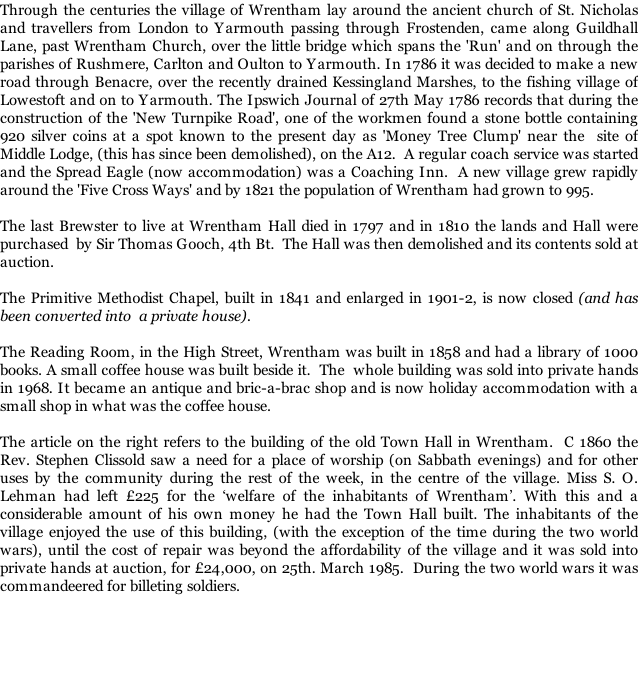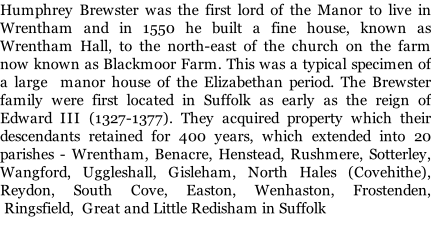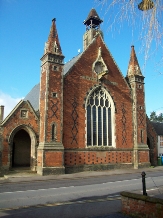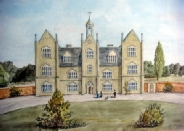

Copyright Wrentham Parish Council

Welcome to Wrentham

A HISTORY OF THE VILLAGE
(See Photographs)

The following article was in the ‘Mercury’ September 8th, 1860 describing the generous action of Steven Clissold
For the information of our readers who may not have heard the antecedent circumstances in connection with this event, we may state, that for some time past the Rev. E. M. Clis-
Not the least pleasing feature in connection with this event is the genuine Catholic spirit of the Rev. S. Clissold, which imparts far greater grandeur to the scheme, than art or embellishment could ever afford. He declares his willingness to recognize as brethren all denominations of Christians, resident in the village, to whom the Hall is as much available for social or other purposes—free of charge— as those belonging to the Church with which he himself stands identified, and this is indeed a bright and cheering fact. There has, for
years past—especially in rural parishes—been too much bigotry and strife amongst professedly religious men, ever to suffer Christianity to flourish, and the sooner it is ended the better will it be for the cause of truth. To Wrentham then we point the attention of all who fancy themselves holier than their brethren, for there we hope and believe it may with truth be said " See how these Christians love one another !"
In the past Wrentham has been called Wrancham, Wrantham, Wretham and Wrettingham. It was mentioned in the Domesday Book. In 1086 the whole of the lands of Wrentham were held by William de Warrens of Varennes, who was one of William the Conqueror's great knights. Having fought at the battle of Hastings and having been involved in the invasion plans he was given 300 manors, half in Suffolk and Norfolk. These included Wrentham, Benacre and Henstead. Later he was created Earl of Surrey, built a castle in Holt, Norfolk, founded Lewes Priory in Sussex and lived mostly at the castle at Lewes. He died in battle in 1089. At this time, the Parish was divided into 6 manors which consisted of 1760 acres of arable land on which the parish was taxed and 604 acres being composed of wood, common and waste land. A parish was like a miniature kingdom. There was an approximate total population of 540. The total population of England was 2 million so Wrentham was considered to be a large settlement. This is shown by the fact that it had two churches, one on the current site and the other the site of which is unknown.
In the centuries which followed the Norman Conquest, the manors were substantially developed, particularly Perpounds, which was South of Wrentham Hall and Poinings, which was North Hall.
In 1307 the tenant in chief of the Manors of Wrentham, known as South Hall and North Hall were the Valences family (Earls of Peinbroke) and under them the lands were held by the families of Pierrepoint and Poynings respectively. These families and their descendants continued to hold the manors until, just prior to the reign of Queen Elizabeth I(1553-
The Old Town Hall







| Information |
| Map |
| Photos |
| Sports & Recreation Facilities |
| Local Attractions |
| Wrentham, Massachusetts |
| church |
| AboutWrenthamVillageHall |
| What's On |
| Booking Information |
| Village Hall History |
| The Windmills of Wrentham |
| Old Photos of Wrentham |
| Wrentham Celebrations |